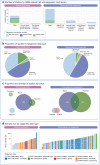Epigenetics and gestational diabetes: a review of epigenetic epidemiology studies and their use to explore epigenetic mediation and improve prediction
- PMID: 31624900
- PMCID: PMC6861541
- DOI: 10.1007/s00125-019-05011-8
Epigenetics and gestational diabetes: a review of epigenetic epidemiology studies and their use to explore epigenetic mediation and improve prediction
Abstract
Epigenetics encapsulates a group of molecular mechanisms including DNA methylation, histone modification and microRNAs (miRNAs). Gestational diabetes (GDM) increases the risk of adverse perinatal outcomes and is associated with future offspring risk of obesity and type 2 diabetes. It has been hypothesised that epigenetic mechanisms mediate an effect of GDM on offspring adiposity and type 2 diabetes and this could provide a modifiable mechanism to reduce type 2 diabetes in the next generation. Evidence for this hypothesis is lacking. Epigenetic epidemiology could also contribute to reducing type 2 diabetes by identifying biomarkers that accurately predict risk of GDM and its associated future adverse outcomes. We reviewed published human studies that explored associations between any of maternal GDM, type 2 diabetes, gestational fasting or post-load glucose and any epigenetic marker (DNA methylation, histone modification or miRNA). Of the 81 relevant studies we identified, most focused on the potential role of epigenetic mechanisms in mediating intrauterine effects of GDM on offspring outcomes. Studies were small (median total number of participants 58; median number of GDM cases 27) and most did not attempt replication. The most common epigenetic measure analysed was DNA methylation. Most studies that aimed to explore epigenetic mediation examined associations of in utero exposure to GDM with offspring cord or infant blood/placenta DNA methylation. Exploration of any causal effect, or effect on downstream offspring outcomes, was lacking. There is a need for more robust methods to explore the role of epigenetic mechanisms as possible mediators of effects of exposure to GDM on future risk of obesity and type 2 diabetes. Research to identify epigenetic biomarkers to improve identification of women at risk of GDM and its associated adverse (maternal and offspring) outcomes is currently rare but could contribute to future tools for accurate risk stratification.
Keywords: Epidemiology; Epigenetics; Gestational diabetes; Mediation prediction; Pregnancy; Review.
Figures



Similar articles
-
Epigenetics of the non-coding RNA nc886 across blood, adipose tissue and skeletal muscle in offspring exposed to diabetes in pregnancy.Clin Epigenetics. 2024 May 7;16(1):61. doi: 10.1186/s13148-024-01673-3. Clin Epigenetics. 2024. PMID: 38715048 Free PMC article.
-
Epigenetic Changes in Gestational Diabetes Mellitus.Int J Mol Sci. 2021 Jul 17;22(14):7649. doi: 10.3390/ijms22147649. Int J Mol Sci. 2021. PMID: 34299269 Free PMC article. Review.
-
Methylation Patterns of Diabetes and Obesity Susceptibility Genes in Gestational Diabetes Mellitus: A Cross-Sectional Analysis from Karachi, Pakistan.Metab Syndr Relat Disord. 2025 Apr;23(3):137-145. doi: 10.1089/met.2024.0171. Epub 2024 Nov 8. Metab Syndr Relat Disord. 2025. PMID: 39515368
-
Gestational Diabetes Mellitus and Developmental Programming.Ann Nutr Metab. 2020;76 Suppl 3(Suppl 3):4-15. doi: 10.1159/000509902. Epub 2021 Jan 19. Ann Nutr Metab. 2020. PMID: 33465774 Free PMC article. Review.
-
Epigenetic signatures of gestational diabetes mellitus on cord blood methylation.Clin Epigenetics. 2017 Mar 27;9:28. doi: 10.1186/s13148-017-0329-3. eCollection 2017. Clin Epigenetics. 2017. PMID: 28360945 Free PMC article.
Cited by
-
Gestational Diabetes Mellitus (GDM) Risk for Declared Family History of Diabetes, in Combination with BMI Categories.Int J Environ Res Public Health. 2021 Jun 28;18(13):6936. doi: 10.3390/ijerph18136936. Int J Environ Res Public Health. 2021. PMID: 34203509 Free PMC article.
-
Cohort Studies and Multi-omics Approaches to Low-Dose Ionizing Radiation-Induced Cardiovascular Disease: A Comprehensive Review.Cardiovasc Toxicol. 2025 Jan;25(1):148-165. doi: 10.1007/s12012-024-09943-5. Epub 2024 Nov 13. Cardiovasc Toxicol. 2025. PMID: 39538046 Review.
-
Developmental programming of insulin resistance: are androgens the culprits?J Endocrinol. 2020 Jun;245(3):R23-R48. doi: 10.1530/JOE-20-0044. J Endocrinol. 2020. PMID: 32240982 Free PMC article. Review.
-
Clinical Characteristics, Outcomes, and Progression to Type 2 Diabetes in Women with Hyperglycemia in Pregnancy.Indian J Endocrinol Metab. 2021 Nov-Dec;25(6):538-544. doi: 10.4103/ijem.ijem_440_21. Epub 2022 Feb 17. Indian J Endocrinol Metab. 2021. PMID: 35355915 Free PMC article.
-
Identification of methylation-driven genes, circulating miRNAs and their potential regulatory mechanisms in gestational diabetes mellitus.Am J Transl Res. 2023 Jan 15;15(1):336-349. eCollection 2023. Am J Transl Res. 2023. PMID: 36777869 Free PMC article.
References
-
- O’Sullivan JB, Mahan CM. Criteria for the oral glucose tolerance test in pregnancy. Diabetes. 1964;13:278–285. - PubMed
Publication types
MeSH terms
Grants and funding
LinkOut - more resources
Full Text Sources

